Salt Lake City's utility service is rolling out a water management analysis and planning software — otherwise known as waterMAPS — to residents. It can be used to track water use, and is a useful tool in water conservation decision making.
The software was developed by a team of USU researchers, across a variety of disciplines, whose goal was to further encourage urban landscape water conservation. The software combines publicly available digital aerial imagery with billing data from land parcels within the system. This information can be used to calculate current water use and compare that to optimal water needs for different landscapes, giving what is referred to as a landscape irrigation ratio.
Laura Briefer is the Director of Salt Lake City Department of Public Utilities.
“First and foremost, it's to give information in a really transparent manner about the efficiency of water use on a residential property, and then give the tools to do something about it, and leave the selection of those tools up to each individual resident, because one type of program might work better than others, depending on what kind of property you have, or what kind of issue you have,” Briefer explained.
Right now waterMAPS has been implemented with the Salt Lake City Department of Public Utilities and can be found through your public utility account. The software will generate a report to help interpret the data that includes water use as well as some recommendations and strategies based on calculated use.
While right now this pilot program is only available to those who are on Salt Lake City’s water system, the hope is to make it replicable to water providers in other areas of the state.
“The wise use, an efficient use of water in our region is really critical, because there's so many environmental values and public values associated with water, and we're not a real water rich area. And so there's always tension around that. But even more so, you know, we have had some quite intense drought,” Briefer said. “And one good year of snowpack isn't necessarily going to solve the longer term problem.
"And so we want to make sure that we're not — I would like to make sure that we aren't losing the opportunity to allow the plentiful water we have this year to go and rehabilitate Great Salt Lake, bring water into Great Salt Lake or in the Great Salt Lake Basin here," Briefer continued. "That's of incredible importance to us, refill our reservoirs, make our streams and rivers healthy.”
For more information visit SLC.gov/utilities/conservation.








